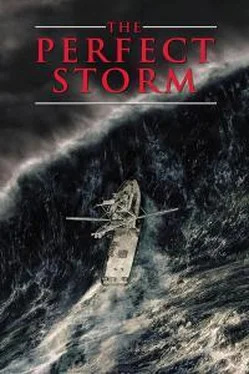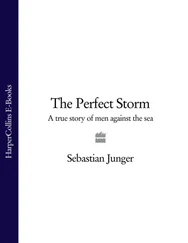Sebastian Junger - The Perfect Storm
Здесь есть возможность читать онлайн «Sebastian Junger - The Perfect Storm» — ознакомительный отрывок электронной книги совершенно бесплатно, а после прочтения отрывка купить полную версию. В некоторых случаях можно слушать аудио, скачать через торрент в формате fb2 и присутствует краткое содержание. Жанр: Триллер, Проза. Описание произведения, (предисловие) а так же отзывы посетителей доступны на портале библиотеки ЛибКат.
- Название:The Perfect Storm
- Автор:
- Жанр:
- Год:неизвестен
- ISBN:нет данных
- Рейтинг книги:3 / 5. Голосов: 1
-
Избранное:Добавить в избранное
- Отзывы:
-
Ваша оценка:
- 60
- 1
- 2
- 3
- 4
- 5
The Perfect Storm: краткое содержание, описание и аннотация
Предлагаем к чтению аннотацию, описание, краткое содержание или предисловие (зависит от того, что написал сам автор книги «The Perfect Storm»). Если вы не нашли необходимую информацию о книге — напишите в комментариях, мы постараемся отыскать её.
The Perfect Storm — читать онлайн ознакомительный отрывок
Ниже представлен текст книги, разбитый по страницам. Система сохранения места последней прочитанной страницы, позволяет с удобством читать онлайн бесплатно книгу «The Perfect Storm», без необходимости каждый раз заново искать на чём Вы остановились. Поставьте закладку, и сможете в любой момент перейти на страницу, на которой закончили чтение.
Интервал:
Закладка:
The problem with a steel boat is that the crisis curve starts out gradually and quickly becomes exponential. The more trouble she's in, the more trouble she's likely to get in, and the less capable she is of getting out of it, which is an acceleration of catastrophe that is almost impossible to reverse. With the boat's bilge partially flooded, she sits lower in the water and takes more and more prolonged rolls. Longer rolls mean less steerage; lower buoyancy means more damage. If there's enough damage, flooding may overwhelm the pumps and short out the engine or gag its air intakes. With the engine gone, the boat has no steerageway at all and turns broadside to the seas. Broadsides exposes her to the full force of the breaking waves, and eventually a part of her deck or wheelhouse lets go. After that, downflooding starts to occur.
Downflooding is the catastrophic influx of ocean water into the hold. It's a sort of death rattle at sea, the nearly vertical last leg of an exponential curve. In Portland, Maine, the Coast Guard Office of Marine Safety has a video clip of a fishing boat downflooding off the coast of Nova Scotia. The boat was rammed amidship by another boat in the fog, and the video starts with the ramming boat backing full-screw astern. It's all over in twenty seconds: the crippled vessel settles in her stern, rears bow-up, and then sinks. She goes down so fast that it looks as if she's getting yanked under by some huge hand. The last few moments of the film show the crew diving off the upended bow and trying to swim to the other boat fifty feet away. Half of them make it, half of them don't. They're sucked down by the vacuum of a large steel boat making for the deep.
Very few boats ever get to that point, of course. They might take water in the hold or lose their antennas or windows, but that's it. The result, fortunately, is that their stability limits are rarely tested in a real-life situation. The only way to know the stability profile for each boat is to perform a standard dockside test on her. A 5,ooo-pound weight is put on deck, ten feet off the centerline, and the resulting angle of heel is run through a standard formula that gives the righting moment. So many things can affect the stability of a boat, though, that even the Coast Guard considers these tests to be of limited value. Load a few tons of gear onto the deck, take a little water in her bilge, shift from longlining to dragging to gillnetting, and the dynamics of the ship change completely. As a result, stability tests are mandatory only for vessels over seventy-nine feet. At deck height, the Andrea Gail measures seventy-two.
When the Andrea Gail was overhauled in 1986, Bob Brown simply pulled her out of the water and started welding; no stability tests were performed, no marine architect was consulted. In the trade this is known as "eyeball engineering," and it includes the Andrea
Gail in an overwhelming majority of the commercial fleet that has been altered without plans. The work was done at St. Augustine Trawlers in St. Augustine, Florida; in all, eight tons of machinery and structural changes were added to the boat, including the fuel and water drums on her whaleback deck.
After the work was finished, marine surveyor James Simonitsch—whose brother, Mark, would propose shutting down Georges Bank the following year—flew to Florida to reinspect the Andrea Gail. Two years earlier he'd appraised both the Hannah Boden and Andrea Gail for the settlement of Bob Browns divorce, and the Andrea Gail had been valued at $400,000. Simonitsch surveyed her again in January, 1987, and wrote a letter to Bob Brown with some minor suggestions: Loosen the dogs on one of the watertight doors and provide flotation collars and lights for the survival suits. Otherwise the vessel seemed shipshape. "The modifications and additional furnishings will increase the vessel's ability to make longer trips and return with a high-quality product," Simonitsch concluded. The question of stability never came up.
In 1990, St. Augustine Shipyards was sold by the Internal Revenue Service for nonpayment of taxes. In October of that year Simonitsch visited the Andrea Gail in Gloucester and made a few more suggestions: professionally service the six-man life raft, replace a dead battery in the Class B EPIRB, and install a flare kit in the wheelhouse. Again, there was no mention of stability tests, but the vessel was well within the law. Bob Brown also neglected to refile documentation for the Andrea Gail after altering her hull, although neither discrepancy was Simonitsch's problem. He was paid to look at a boat and evaluate what he saw. In November, 1990, the principal surveyor for Marine Safety Consultants, Inc., the company that employed Simonitsch, inspected the Andrea Gail one last time. "The vessel is well suited for its purpose," he wrote. "Submitted without prejudice, David C. Dubois."
If Billy Tyne were inclined to worry, though, there were a number of things about the Andrea Gail that might have given him pause. First of all, according to Tommy Barrie of the Allison, she had a boxy construction and a forward wheelhouse that took the seas hard. She was a rugged boat that didn't concede much to the elements. And then there were the St. Augustine alterations. The extended whaleback deck was burdened with the weight of an icemaker and three dozen fifty-five-gallon drums, so her center of gravity had been raised and she would recover from rolls a little more slowly. Only a couple of other boats in the fleet—the Eagle Eye, the Sea Hawk—store fuel oil on their upper decks. The portside bulwark on the Andrea Gail could be a problem, too. It had been raised and extended to protect the fishing gear, but it also tended to hold water on deck. A few years earlier, she'd taken a big sea over the stern and was pushed so far over that her rudder came partway out of the water. Bob Brown was on board, and he sprinted up to the wheelhouse and put the helm around; at the same moment the boat rode up the face of another big sea. Slowly, the Andrea Gail righted herself and cleared her decks; everything was fine except that the bulwark had been flattened like a tin can.
One could argue that if a wave takes a piece of a boat out, maybe it shouldn't be there.
Or one could argue that that's just what waves do—tear down what men put up. Either way, the incident was unsettling. Brown blamed it on the inexperience of the man at the helm and said that it was his own quick action that saved the boat. The crew didn't see it that way. They saw a boat pinned on her port side by a mass of water and then righted by freak wave action. In other words, they saw bad luck briefly followed by good. The bulwark was replaced as soon as they got in, and nobody mentioned it again.
Bob Brown's reputation in Gloucester is a complex one. On the one hand he's a phenomenally successful businessman who started with nothing and still works as hard as any crew member on any of his boats. On the other hand, it's hard to find a fisherman in town who has anything good to say about him. Fishing's a marginal business, though, and people don't succeed in it by being well liked, they succeed by being tough. Some— such as Gloucester fisherman "Hard" Bob Millard— are tough on themselves, and some are tough on their employees. Brown is tough on both. When he was a young man, people called him Crazy Brown because he took such horrific risks, tub-trawling for cod and haddock in an open wooden boat all winter long. He had no radio, loran, or fathometer and worked alone because no one would go with him. He remembers winter days when he had to slide a skiff out across the harbor ice just to get to his mooring. "I had a family to feed and I was intent upon doing that," he says.
Only once in his life did he work for someone else, a six-month stint with a company that was exploring the lobster population on the continental shelf. That was in 1966; three years later he was working two hundred miles offshore in a forty-foot wooden boat.
Читать дальшеИнтервал:
Закладка:
Похожие книги на «The Perfect Storm»
Представляем Вашему вниманию похожие книги на «The Perfect Storm» списком для выбора. Мы отобрали схожую по названию и смыслу литературу в надежде предоставить читателям больше вариантов отыскать новые, интересные, ещё непрочитанные произведения.
Обсуждение, отзывы о книге «The Perfect Storm» и просто собственные мнения читателей. Оставьте ваши комментарии, напишите, что Вы думаете о произведении, его смысле или главных героях. Укажите что конкретно понравилось, а что нет, и почему Вы так считаете.












